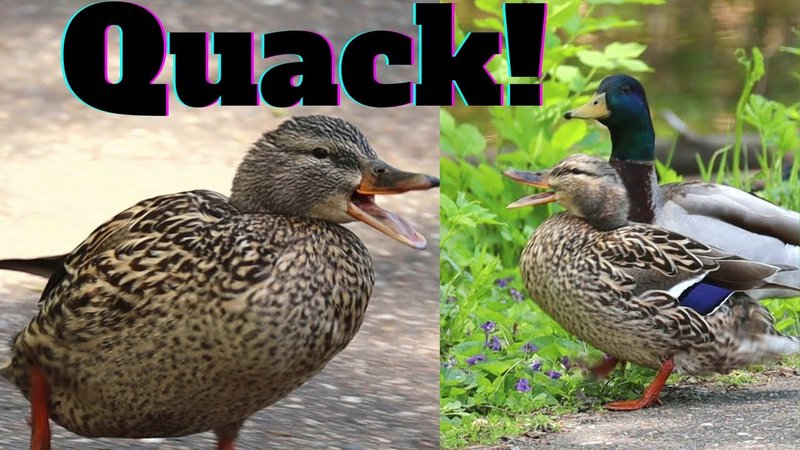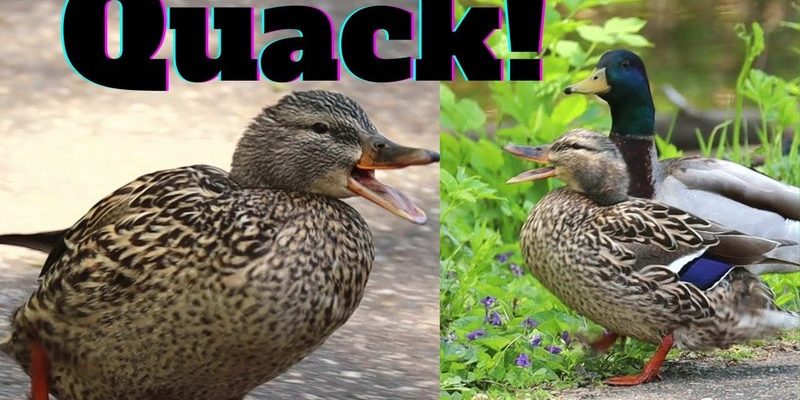
Let’s dive deeper into the fascinating world of ducks. Understanding their quacking, mating rituals, and social habits is like being given a front-row seat to nature’s own soap opera. You might be surprised to learn that their behaviors can tell us quite a bit about their personalities. From the way they engage in playful banter to the more serious moments during mating season, there’s a lot happening under the surface. This blog will guide you through all the quirks and intricacies of duck behavior, showing you how these charming creatures communicate and interact within their community.
The Art of Quacking: Why Ducks Make Noise
Ducks are known for their quacking, but not all ducks quack in the same way. When we hear a duck quack, we often think of the classic “quack-quack,” but that’s just scratching the surface. Different species have their unique vocalizations. For instance, female mallards are famous for their loud quacking, while drakes (male ducks) are more likely to produce softer sounds.
So, why do they quack? Well, ducks use quacking as a form of communication. It helps them signal to each other about various things—whether it’s a warning about potential danger, a call to gather, or even a way to establish their territory. Honestly, it’s like having a verbal map of their world. For example, if you hear a frantic quacking, it could mean that there’s a predator nearby, while a series of softer quacks might be a friendly chat between two pals.
Moreover, ducks have other methods of communication besides quacking. They use body language, too! You might notice them bobbing their heads or flapping their wings when excited. These gestures, combined with their vocalizations, create a rich tapestry of social interaction. Understanding these sounds can help you appreciate the complexity of their social lives, much like learning the nuances of a new language.
Mating Rituals: Duck Courtship Explained
Duck mating rituals can be both fascinating and a bit comical. When it comes to attracting a mate, male ducks often put on quite the show. Imagine a peacock showing off its feathers, and you’ll get the idea. Male ducks will perform elaborate displays, which may include splashing water, flapping their wings, and even making specific calls. They’re trying to impress the females, showcasing their vitality and fitness.
During mating season, you might notice more aggressive behavior among males. They’ll compete for the attention of females, often displaying dominance through posturing and vocalizations. You might see them chasing each other around, quacking loudly in what seems like a playful yet serious contest for affection.
Once a pair forms, duck couples can become quite affectionate. They often engage in mutual preening, helping to strengthen their bond. You could say it’s their version of a couple’s spa day! These rituals are vital not just for reproduction but also for establishing strong family units, which is crucial for raising ducklings.
Social Structure: How Ducks Interact in Groups
Ducks are social creatures that thrive in groups, called flocks. The dynamics of duck social behavior can be compared to a small community. Within a flock, ducks establish social hierarchies, leading to interesting interactions. You might notice that some ducks take on leadership roles, guiding the group to feeding spots or safe areas.
In these flocks, you’ll often see a high level of cooperation. Ducks will often help keep an eye out for predators while others are feeding. It’s like having a buddy system: “You watch my back, and I’ll watch yours.” This behavior enhances their chances of survival in the wild, as a vigilant flock can quickly alert each other to danger.
Interestingly, ducks also show signs of friendship. You might see them pair up and spend time together, swimming side by side or resting close. These bonds can be lifelong, and it’s heartwarming to witness how they support each other within their community.
Feeding Habits: What Do Ducks Eat and How Do They Share?
Ducks are omnivores, meaning they eat both plants and animals. Their diet typically includes aquatic plants, insects, small fish, and even crustaceans. You might find them dabbling in the water or foraging on land, using their beaks to sift through mud and debris.
A fun fact: ducks often have a pecking order when it comes to feeding. The more dominant ducks tend to eat first, while those lower in the hierarchy might wait their turn. This feeding behavior is essential for maintaining order within the flock. If you’ve ever watched ducks at a pond, you might notice how organized their feeding can be, almost like a well-rehearsed dance.
Sharing food is also a common sight. If one duck finds a particularly tasty morsel, others may gather around to take advantage. It’s a communal affair—much like how human friends will share a plate at a restaurant. This interaction fosters social bonds and enhances their overall flock dynamics.
Behavioral Changes: Seasonal and Environmental Influences
Duck behavior can change significantly with the seasons. During the warmer months, you’ll find them active and sociable, often seen foraging and exploring. As winter approaches, many species migrate to warmer climates, demonstrating a fascinating instinctual behavior. Migration helps them avoid harsh winter conditions and ensures a steady food supply.
Moreover, environmental factors can influence their behavior in other ways. For instance, changes in water quality or food availability can lead to increased competition, which may heighten aggressive behavior among males. Ducks are incredibly adaptable, though. They can quickly adjust their habits based on the availability of resources, showcasing their resilience.
Another interesting aspect is how ducks respond to humans. In urban areas, you may find them becoming more comfortable around people, leading them to approach for food. However, this interaction can be a double-edged sword, as it might make them more vulnerable to danger. Recognizing these changes in behavior can deepen your understanding of how ducks coexist with their environment.
Understanding duck behavior—like quacking, mating, and social habits—offers a window into their fascinating world. Just like us, they have their ways of communicating and forming relationships. Whether it’s the playful quack of a mallard or the serious courtship displays of a drake, each behavior adds depth to their social tapestry.
So, the next time you see a group of ducks, take a moment to observe. You might notice their unique personalities shining through in their interactions. Just like a lively conversation at your favorite café, there’s so much happening beneath the surface. Ducks are not just charming creatures; they are complex beings with rich social lives that mirror our own in many ways.
As you continue to explore the beauty of the animal kingdom, remember that every creature has its own story to tell. Embrace the adventure!

